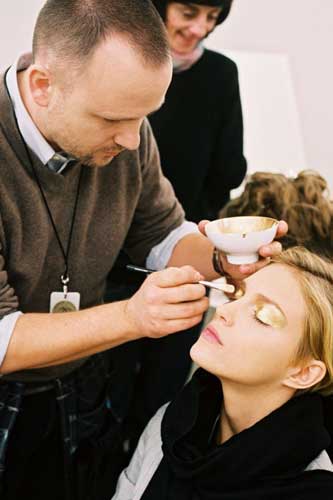Peter Philips: Chanel's golden boy
Two decades ago, Peter Philips never realised you could get paid to put lippy on; now he's got the biggest budget in make-up and the world is his compact

They say that nail varnish, like chocolate, is a treat women can still afford when the economy stumbles. If that's the case, there'll be a stampede when the most indulgent crunch-busting purchase of the day, Chanel's Gold Fiction, hits counters at the end of the month. Chanel has made blood-coloured, black and even navy-blue nails the very definition of chic (for under £20 a pop). Its latest colour isn't for the faint-hearted either. Paint it on and your hands appear literally gilded. But it's not only what's inside that counts. Packaged in a heavyweight glass bottle with a glossy, black squared-off plastic cap, the Modernist sans-serif letters on each and every product spell out a name that, to women everywhere, translates as grown-up glamour: C-H-A-N-E-L.
The closest most of us get to owning a piece of Chanel, one of the world's most successful and fiercely guarded luxury brands, is its lipstick, nail polish or a bottle of its bestselling No5 perfume. So the person who creates those desirable items is, in artistic terms at least, in charge of the greater part of its business.
That person is now Peter Philips, the new global creative director of Chanel make-up, a softly-spoken Belgian with dark blond hair and a calm demeanour. Replacing Dominique Moncourtois and Heidi Morawetz, long-time co-directors of Chanel's beauty division (Moncourtois had been the last employee to have been hand-picked by the late Mlle Chanel herself), Philips has inherited a legacy of luxurious packaging and technical innovation.
In many ways, he's not the obvious choice. A graduate of the prestigious Antwerp Academy (where a generation of Belgian fashion talent, including Martin Margiela and Ann Demeulemeester, studied), Philips abandoned fashion design to take up a career in make-up after working as a "dresser" backstage at the prêt-à-porter shows in Paris. "I saw the make-up teams and realised you could make a living out of doing that. For me, make-up had always been associated with beauty parlours. I always did my friends' make-up in the 1980s; they'd ask, 'Can you do my eyes?' and I was good at it. So when I realised that in fashion you could also do make-up, I was intrigued." Philips began to work on shoots and at shows, although he notes he was "very selective" with whom he collaborated.
After a decade at the top of the industry, he had gained a reputation as one of fashion's best avant-garde talents – albeit one associated with menswear shoots (he's close friends with men's fashion star Raf Simons) and the edgier style mags. Forget cover girls with pretty-pretty pink cheeks and smoky eyeshadow; one of the most enduring images Philips has produced was a portrait of a male model, his face obscured by an enormous cartoon Mickey Mouse. "It was spontaneous," he recalls of that session. "But when we showed the picture to other people, their jaws just dropped."
Until now, itinerant hardly sums up Philips's lifestyle as a hard-working session artist – "I don't know where I live really. Hotels..." In demand by every star photographer, the 40-year-old was not in the market for the quiet corporate life of an in-house role at a beauty brand. But the top job at Chanel is a mantle that Philips treats very seriously, not to say emotionally. The prolonged period of negotiation he had with the company was, he says, akin to "an engagement. It's a commitment. But now we are married. Everything at the house of Chanel is intimate, it's like a family."
Working from an airy studio in Paris and the company's laboratory, Philips now collaborates with Karl Lagerfeld on Chanel's catwalk shows and advertising imagery. He's bubbling over with excitement at the R&D side of his new job. With the infinite budgets of Chanel at his disposal, Philips can now develop new products "from scratch to end product, so if I have an idea – say, a 'floating foundation' – I can get people on to doing research into that. Or if I want to change the pigments we use, I can get our team to work on the formulas. I'm not a chemist – but now I've got a team working for me to do that."
The first of his products for the brand, including that gold nail polish, go on sale later this month. Don't expect a radical revision of classic Chanel products. Any visible changes to the brand will be "very subtle – unlike the other beauty brands, Chanel doesn't have to reinvent itself every five years, because it's so classic".
Instead, he promises his labs will continue to produce the hysteria-inducing "star" products that set trends everywhere. "I remember when they did Rouge Noir, I was a kid in those days, and you couldn't find a dramatic red. Suddenly, Chanel did Rouge Noir – a colour that other brands would be afraid of. When Chanel did it, it was a classic. The same with the black polish."
One of his predecessors, the genteel Moncourtois, stayed in this job for several decades. Does Philips believe this could be a marriage for life? "I never really plan anything," he insists. "Three years ago I would never have dreamt that I'd be at Chanel. But, if I'm happy with it, maybe I can stay here till I'm 80."
Join our commenting forum
Join thought-provoking conversations, follow other Independent readers and see their replies
Comments
Bookmark popover
Removed from bookmarks